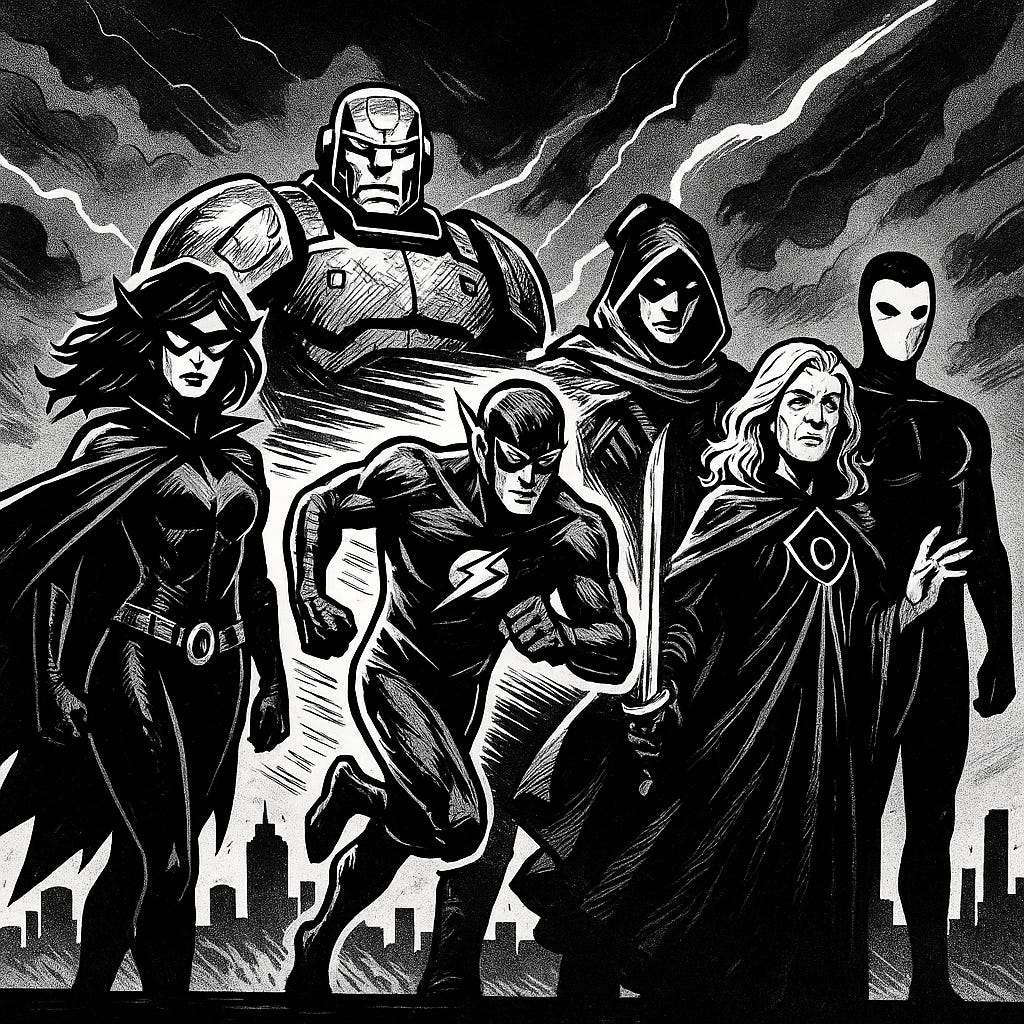In this series of posts, I’ll share thoughts and commentary on the complete revision of the 12 Loner Complete Adventure Packs — all of which are being reworked for inclusion in the upcoming Loner Anthology.
I’m not a huge fan of the superhero genre. I appreciate it — the archetypes, the legacy, the sheer spectacle — but I don’t love it. So working on this module was, let’s say, a personal detour through unfamiliar streets. I know the terrain: I’ve read the big titles, followed the obscure runs, and traced the genre from grim-and-gritty to cosmic absurdity and back. But writing a solo RPG pack about capes? That was another matter.
Still, there was a tone I knew I wanted: something Silver Age. Shiny but fractured. A world where public optimism meets secret trauma. And that became the backbone of this pack.
So: welcome to Metropia — a city on the edge of collapse and comeback. A vertical neon fortress where old guard heroes train unstable proteges, media wars reshape truth, and power is never just physical. In a sense, this pack is about what comes after heroism — legacy, regret, surveillance, burnout.
Power, Pressure, and Public Image
What makes the Superheroes Adventure Pack work in solo mode isn’t the genre itself, but the conflict it invites: internal, relational, political. You’re not just fighting villains — you’re being watched, measured, interpreted. The Public Perception mechanic embodies this. After key actions, you roll to see how your choices shift your standing. Are you beloved? Suspected? Exploited? Heroes in this world are as much narrative constructs as they are agents of justice.
There’s also the Signature Power Surge, one of my favorite little rules: once per mission, you can skip the Oracle and just say yes to a dramatic burst of power — a heroic moment, a sacrifice, a leap into the sky. But it costs you the Drained condition, and maybe more. It's less about mechanics and more about spotlight: that beat in the comic when everything turns on a single page-turn.
Characters range from weary vigilantes and child prodigies to rogue androids and media-savvy enforcers. The tables cover origin stories, nemesis factions, strange abilities, and urban myths. One of the best parts was writing the Factions — because in a superhero world, power is always collective, historic, and under scrutiny. You’ll meet groups like:
The Emerald Civic Guard, a post-human agency accountable to no one
The Legacy Council, protectors of heroic bloodlines and reputation
The Twilight Allegory, poetic rebels who weaponize symbolism
What's Inside
This pack leans fully into genre tropes as game fuel, not static flavor. Here's what made the cut:
Tags for powers, nemeses, relationships, and traumas — everything grounded in Loner’s descriptive engine.
Factions that each mirror an angle of the genre: idealism, authoritarianism, disillusionment, mutation.
D66 story hooks, each rooted in moral tension, identity crisis, or impossible choice.
Complication mechanics for press, fame, backlash, and personal struggle.
Locations like The Folded Tower, Mirror City, and Outpost K — each ready to fold into your emergent narrative.
If you want a bright, high-flying world with jagged edges — one where capes are currency and trauma is archived — this is the module.
Unmasked
I came into this module reluctantly. But I left it with a kind of weird affection. It’s not a setting I’d live in — but it’s one I’d absolutely ruin with a good story.
This is the third stop on the road to the Loner Anthology. Next up: Crime.
Until then, mask up. Or don't.
— Roberto





Awesome!